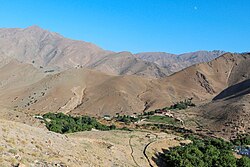Navoiy Region
Navoiy Region
Навоий вилояти / Navoiy viloyati (Uzbek) | |
|---|---|
Region | |
 | |
 Navoiy in Uzbekistan | |
| Coordinates: 42°0′N 64°15′E / 42.000°N 64.250°E | |
| Country | Uzbekistan |
| Capital | Navoiy |
| Government | |
| • Hokim | Normat Tursunov |
| Area | |
| • Total | 111,095 km2 (42,894 sq mi) |
| Elevation | 126 m (413 ft) |
| Population (2022) | |
| • Total | 1,033,857 |
| • Density | 9.3/km2 (24/sq mi) |
| Time zone | UTC+5 (East) |
| • Summer (DST) | UTC+5 (not observed) |
| ISO 3166 code | UZ-NW |
| Districts | 8 |
| Cities | 7 |
| Towns | 46 |
| Villages | 582 |
| Website | www |

Navoiy Region (Uzbek: Навоий вилояти, Navoiy viloyati, Russian: Навоийская область, romanized: Navoiyskaya oblast) is one of the regions of Uzbekistan. It is located in the central north/northwest of the country. It covers an area of 111,095 km2 (42,894 sq mi) (a large part of which is taken up by the Kyzyl-Kum desert), which makes it the largest of the regions of Uzbekistan (the autonomous Karakalpakstan Republic is still larger at 166,590 km2).[1] The Navoiy region borders with Kazakhstan, Samarqand Region, Buxoro Region, Jizzakh Region, and the Karakalpakstan Republic. The population is estimated 1,033,857 (2022), with 51% living in rural areas.[2][3] The capital is Navoiy (pop. est. 146,900).[4] The region and its capital are named after the poet Ali-Shir Nava'i.
The climate is a typically semi-desert continental climate. Navoiy region has significant natural resources, especially natural gas, petroleum, and precious metals, plus raw materials for construction. The region's economy is heavily dependent on large mining, metallurgical and chemical production complexes. The Navoi and Zarafshan mines produce some of the world's purest gold.
Leading agricultural products are cotton and Karakul sheep. Some 90% of the entire area is considered potentially rich agricultural land, if a source of water for irrigation can be located.
Administrative divisions

The Navoiy Region consists of 8 districts (listed below) and three district-level cities: Navoiy, Zarafshon and Gʻozgʻon.[1][4]
| Key | District name | District capital |
|---|---|---|
| 1 | Konimex District | Konimex |
| 2 | Qiziltepa District | Qiziltepa |
| 3 | Xatirchi District | Yangirabod |
| 4 | Navbahor District | Beshrabot |
| 5 | Karmana District | Karmana |
| 6 | Nurota District | Nurota |
| 7 | Tomdi District | Tomdibuloq |
| 8 | Uchquduq District | Uchquduq |
There are 7 cities (Navoiy, Zarafshon, Gʻozgʻon, Qiziltepa, Nurota, Uchquduq, Yangirabod) and 46 urban-type settlements in the Navoiy Region.[1][4]
Economy
Navoiy Region is located in the central part of Uzbekistan, being one of the largest industrial centres of the country. The region possesses rich minerals and raw materials resources – Muruntau gold-bearing field, silica sand fields (of more than 1.5 billion tons), deposits of granite (1.9 billion cubic meters), marble (420 million cubic meters), phosphorites (1.5 billion tons) and many others.
Navoiy Mining and Metallurgy Combinat – the biggest enterprise of the region, is included in top ten largest world producers of uranium and gold (9999 standard). Gold bars produced by the Combinat are awarded with the status of “optimal gold delivery” by London Precious Metals Market and Tokyo Commodities Exchange. Along with mining, the region’s economy is based on production of building materials, chemical, textile and food industries.
40 foreign investment enterprises operate in Navoiy Region. Most of them are established with participation of investors from USA, China, Russia and the United Kingdom – Uzbek-British Joint Venture “Amantaytau-Goldfields” is successfully working in the region. [5] [6]
In 2019 the entire region was made a "free economic zone" by presidential decree.[7]
Main sights
The Mausoleum of Sheikh Khoja Khisrav is a pilgrimage site located in the Karmana District of Navoiy Region.[8] Khoja Khisrav was a saint who lived during the 14th century, alongside Mawlana Orif Deggaroni and Khwaja Bakhouddin.[9][10] Information about the life, activities, and miracles of Khoja Khisrav can be found in the book "Bahouddin Balogardon" by Abul Musin Muhammad Boqir Ibn Muhammad Ali.
References
- ^ a b c "Oʻzbekiston Respublikasining maʼmuriy-hududiy boʻlinishi" [Administrative-territorial division of the Republic of Uzbekistan] (in Uzbek). The State Committee of the Republic of Uzbekistan on statistics. July 2021. Archived from the original on 4 February 2022.
- ^ "O'zbekistonda eng ko'p aholi qaysi viloyatda yashaydi?". Qalampir.uz (in Uzbek). Retrieved 2022-02-10.
- ^ a b c "Classification system of territorial units of the Republic of Uzbekistan" (in Uzbek and Russian). The State Committee of the Republic of Uzbekistan on statistics. July 2020.
- ^ Uzinfoinvest Agency
- ^ "Investment Guide for Navoi Region".
- ^ "Dentons - Uzbekistan has declared its largest region a free economic zone".
- ^ "Актуальные направления развития паломнического туризма в Узбекистане" (PDF). dspace.spbu.ru. Retrieved 2023-12-11.
- ^ "В Узбекистане открыли исторический памятник пропагандисту учения Накшбанди". regnum.ru. Retrieved 2023-12-11.
- ^ "КАРМАНА - НАВОИ". www.orient-tracking.com. Retrieved 2023-12-11.

